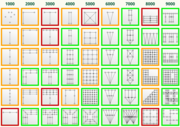Apple
While apple trees are beautiful ornamental fruit, they really do belong out in the open field (free-standing) and not on walls. Most apple varieties are already demanding enough and won't really benefit from a wall microclimate. Instead of using the extra heat to mature fast, they tend to lose their aroma and tanginess (acidity) and become susceptible to diseases or pests. Wire trellises like the 0050 may be used to build free-standing trellises for one or more apple trees. If there is no other space in the garden, it is then worth it to try growing them as espaliers on the facade. Wire trellises like the 0050 may be used to build free-standing trellises for one or more apple trees.
(lat.: Malus domestica)

How to thrive... where to find...
Apples should be grown on west facing walls, because apples can "boil" if the temperature is too high, which is possible on hot south walls. The soil should be deep, humus-rich, and damp with a good water supply. The weaker the grafted rootstock, the less the tree should share the soil with other plants, bushes, or grasses. In extreme cases the ground needs to be mulched. Apple trees are available in tree nurseries or through mail order companies online.
Apple Varieties and Rootstocks / Grafting
To insure fertilisation, you'll want to always have two apple varieties that match each other, either as two single plants or as one espalier apple with double grafting. There are special varieties of espalier fruit which are in high demand as rarities, like "White Winter Calvill." Many of the old varieties are, however, susceptible to mildew and therefore not so suitable as wall espaliers. New, multi-resistant varieties are often better, e.g. the RE varieties from Dresden-Pillnitz.
Apple trees are always grafted; for low trellises (height x width: 3 m x 2 m) they are grafted mostly on the slowly growing rootstock "M9." Such graftings are then sold as "low trunk," "quarter standard," "bush," or "tall spindles." There are also expensive trees available that are pre-trained as espaliers. The lifespan of an espalier is only 20 years. For medium-sized espaliers (height x width: 4 m x 3 m), apples on the stronger base "M 26" should be used; these trees are sold as "half standard." Larger trellises (height x width: 6 m x 3 m) require medium-strong rootstocks- such as "M 4," "M 7," or "MM 106," having a lifespan of 30-50 years. Columnar apple trees and dwarf apple trees are not suitable for facades.
Training Forms, Pruning, and Climbing Supports
Below is a table of all suitable shapes for wire rope trellises. For an optimal distance between the tree and the facade, choose a trellis in our heavy or massive range; a system in the medium or easy range would also work. Apple espalier trees can be grown on a wooden trellis. In an open field / free-standing situation, use a 0050 trellis.
The trees are trained to their final shape through pruning, bending, and binding. Apple espaliers are usually grown as "tall spindles" (see photos below). Older names for this shape are "vertical cordon" or "vertical cord tree." The fruit-bearing wood shoots then branch off directly from the middle trunk and are tied horizontally about 60 cm above the ground in tiers every 40 cm or so. In this way, apple 'hedges' can also be created. Other shapes, such as the Palmette Verrier, are used for larger trellises. Technical literature on pruning is available online. If pruning is done incorrectly or not at all, the trees will bear fewer fruits or may not bear any fruit! The design of the trellis and the shape of the tree need to fit each other. As described in the section on shaped trees, the main axes of the trellis should be 35 - 40 cm apart.
Wire rope trellises for apple trees
Please click on the graphic illustrations for details!
| = suitable | = of limited suitability | = unsuitable |


















































































